

Just-Launched Spacecraft Will Use Grappling Hook to Destroy Space Junk. It uses a magnetic grappling hook to catch space junk and fling it into an incineration orbit.

Drag and Drop A Japanese company called Astroscale is tackling the increasingly dangerous cloud of space junk orbiting our planet and the real threat it poses to satellites and other spacecraft. The company launched a new kind of satellite called the End of Life Services by Astroscale-demonstration (ELSA-d) on Monday, Quartz reports. Soon, ELSA-d will use a powerful magnet to latch onto a doomed companion satellite and fling it down into a lower orbit where the ill-fated companion will incinerate upon reentry into the atmosphere.
Meanwhile ELSA-d will remain safely stationed in a higher orbit, ready and waiting for the next mission — a demonstration of how it could help clean up other garbage in orbit. Chicken and Egg The problem facing companies like Astroscale is that they’re entering such a new industry. New Industry READ MORE: Robot garbage hunters are coming to clean up space [Quartz] Microbes Unknown to Science Discovered on The International Space Station. The menagerie of bacterial and fungal species living among us is ever growing - and this is no exception in low-gravity environments, such as the International Space Station (ISS).
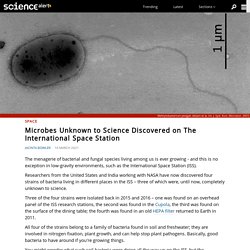
Researchers from the United States and India working with NASA have now discovered four strains of bacteria living in different places in the ISS – three of which were, until now, completely unknown to science. All four of the strains belong to a family of bacteria found in soil and freshwater; they are involved in nitrogen fixation, plant growth, and can help stop plant pathogens. Basically, good bacteria to have around if you're growing things. Allan McDonald Dies at 83; Tried to Stop the Challenger Launch. At that point Mr.
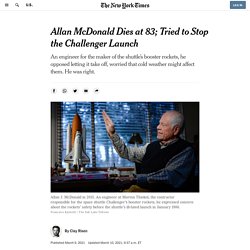
McDonald, sitting in the back of the room, stood up. His hands shaking, he told the panel that Mr. Mulloy was not giving them the whole story; the engineers, he said, had been pressured and overruled. Mr. Ignition, Liftoff. click 2x. New: Mars In 4K. In the Blink of an Eye: Space in an Instant. What to do when an astronaut dies in space. Courtesy of Warner Bros.
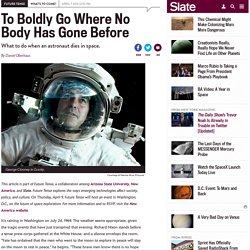
Pictures This article is part of Future Tense, a collaboration among Arizona State University, New America, and Slate. Future Tense explores the ways emerging technologies affect society, policy, and culture. On Thursday, April 9, Future Tense will host an event in Washington, D.C., on the future of space exploration. The Earth - A Living Creature (The Amazing NASA Video) 1080p. Photojournal: NASA's Image Access Home Page. Photos of SpaceX's astronaut flight to the space station. SpaceX launched its first full astronaut crew for NASA on Sunday.NASA astronauts Mike Hopkins, Victor Glover, Shannon Walker, as well as Japanese astronaut Soichi Noguchi rocketed to the International Space Station.Their Crew Dragon spaceship docked to the station the next day, kicking off what's expected to be NASA's longest human spaceflight ever.Photos and gifs reveal the anticipation and joy of the Crew-1 mission so far.Visit Business Insider's homepage for more stories.
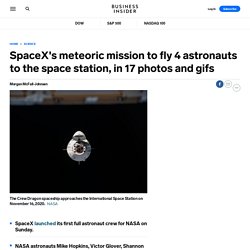
SpaceX has successfully launched four astronauts into Earth's orbit and carried them to the International Space Station in its most ambitious mission yet for NASA. On Monday night, the company's Crew Dragon spaceship maneuvered into position in front of the ISS, slowly inched forward, then gently bumped into an ISS port and locked itself in. NASA's OSIRIS-REx Probe Successfully Stows Space-Rock Sample. NASA's pioneering OSIRIS-REx probe has bagged up its precious asteroid sample for return to Earth.
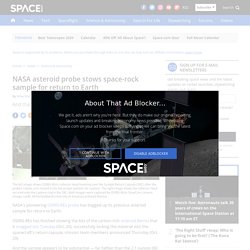
OSIRIS-REx has finished stowing the bits of the carbon-rich asteroid Bennu that it snagged last Tuesday (Oct. 20), successfully locking the material into the spacecraft's return capsule, mission team members announced Thursday (Oct. 29). And the sample appears to be substantial — far heftier than the 2.1 ounces (60 grams) the mission had set as a target, team members said. Indeed, OSIRIS-REx collected so much material on Oct. 20 that its sampling head couldn't close properly; the head's sealing mylar flap was wedged open in places by protruding Bennu pebbles. The International Space Station's 1st crew recalls a Halloween launch 20 years ago. Next week, the International Space Station will hit a major milestone: 20 years of continuous crewed operations — two decades in which there have always been humans in space.
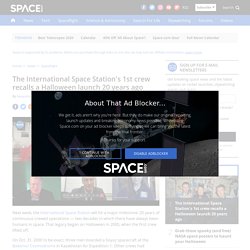
That legacy began on Halloween in 2000, when the first crew lifted off. On Oct. 31, 2000 to be exact, three men boarded a Soyuz spacecraft at the Baikonur Cosmodrome in Kazakhstan for Expedition 1. Other crews had traveled into space to assemble the space station, but when the Expedition 1 crew arrived there on Nov. 2, NASA astronaut William Shepherd and Russian cosmonauts Sergei Krikalev and Yuri Gidzenko became the first official crew to live aboard the space station.
Although much of their four-month mission was spent getting the space station ready for many future crews to live (somewhat) comfortably, they also performed the first scientific experiment on the ISS. In anticipation of their mission's 20th anniversary, Shepherd, Kirkalev, and Gidzenko spoke with NASA about their historic mission. Working together. Long-Duration Spaceflight Alters Brain Connectivity: Study. An international team of scientists has found alterations of task-based functional brain connectivity in a group of astronauts after a long-duration spaceflight.

The findings appear in the journal Frontiers in Physiology. JAXA astronaut Aki Hoshide, ISS Expedition 32 flight engineer, taking a space selfie during extravehicular activity on September 5, 2012, with the Sun behind him. Image credit: NASA. In the study, Dr. Ekaterina Pechenkova of the HSE Laboratory for Cognitive Research and colleagues compared brain activation and connectivity in two groups: a group of 11 astronauts before and after long-term spaceflight, and healthy controls scanned twice with a comparable interval.
“We used functional magnetic resonance imaging (fMRI) to measure functional brain connectivity in a group of eleven astronauts,” the researchers said. Apollo 11 Moon Landing: Photos From 50 Years Ago. On July 20, 1969, the astronaut Neil Armstrong became the first human being to walk on another world, famously marking the moment with the phrase: “That’s one small step for [a] man, one giant leap for mankind.”
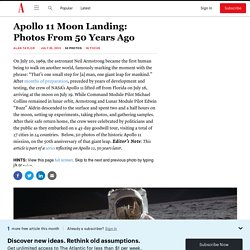
After months of preparation, preceded by years of development and testing, the crew of NASA’s Apollo 11 lifted off from Florida on July 16, arriving at the moon on July 19. While Command Module Pilot Michael Collins remained in lunar orbit, Armstrong and Lunar Module Pilot Edwin “Buzz” Aldrin descended to the surface and spent two and a half hours on the moon, setting up experiments, taking photos, and gathering samples. After their safe return home, the crew were celebrated by politicians and the public as they embarked on a 45-day goodwill tour, visiting a total of 27 cities in 24 countries.
Below, 50 photos of the historic Apollo 11 mission, on the 50th anniversary of that giant leap. Editor’s Note: This article is part of a series reflecting on Apollo 11, 50 years later. Apollo 11: 'The greatest single broadcast in television history' Image copyright Getty Images The mesmerising television coverage of the Apollo 11 moon landing 50 years ago brought previously unthinkable images and ideas into the homes of millions, leaving a profound impact on pop culture and the American psyche.
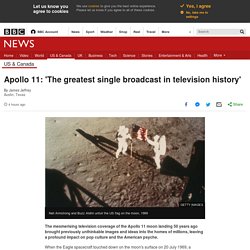
When the Eagle spacecraft touched down on the moon's surface on 20 July 1969, a television camera mounted on its side captured the first tentative steps and words of astronaut Neil Armstrong and sent them across hundreds of thousands of miles to hundreds of millions of pairs of eyes glued to television sets. Walter Cronkite, anchoring the CBS network coverage of the Apollo 11 mission, was initially left speechless.
Eventually he managed to exclaim, "Man on the moon!... Oh, boy…Whew, boy! " Later he recalled he had hoped to say something more profound but the words that came out were "all I could utter". Image copyright Dolph Briscoe Center for American History The enormity wasn't lost on Mr Sills' grandfather, either, watching beside him. Restored Mission Control comes alive 50 years after Apollo. HOUSTON (AP) — Gone is the haze of cigarette, cigar and pipe smoke. Gone are the coffee, soda and pizza stains. With only a few exceptions, NASA’s Apollo-era Mission Control has been restored to the way it looked 50 years ago when two men landed on the moon.
It gets the stamp of approval from retired flight director Gene Kranz, a man for whom failure — or even a minor oversight — is never an option. Seated at the console where he ruled over Apollo 11, Apollo 13 and so many other astronaut missions, Kranz pointed out that a phone was missing behind him. And he said the air vents used to be black from all the smoke, not sparkly clean like they are now. Those couple of details aside, Kranz could close, then open his eyes, and transport himself back to July 20, 1969, and Neil Armstrong and Buzz Aldrin’s momentous moon landing.
Future - Apollo in 50 numbers: Medicine and health. 24: Number of decongestant tablets taken by the Apollo 7 crew Launched on 11 October 1968, Apollo 7 was the first manned test of the Apollo spacecraft in Earth orbit. After the deaths of the Apollo 1 crew in a fire, the command module had been completely redesigned. There was a lot resting on this mission. If Apollo 7 failed, it’s likely that Neil Armstrong would never have made his small step.
Future - Apollo in 50 numbers: The workers. 400,000: Total Apollo workforce Neil Armstrong was one of Nasa’s most accomplished pilots. As he descended towards the lunar surface on 20 July 1969, the success or failure of the first Moon landing depended on the skills, reactions and expertise of this one man. With a boulder field ahead of him, alarms sounding and fuel running low, he guided the spacecraft to the ground. Future - Apollo: The missions to the Moon in 50 fascinating numbers. The seed was sown in July 1960. With the first man in space nearly a year away, and the Mercury programme still with three years to run, Nasa’s Space Task Group (STG) set in motion an ambitious task – a spacecraft big enough and complex enough to carry three astronauts in orbit around the Earth.
It should, if needed, be able to carry out an even more impressive feat: fly in orbit around the Moon and launch a lander that would allow humanity to step on another celestial body for the first time. Launched with historic fanfare in May 1961, the Apollo Program became Nasa’s most famous project – a multi-billion-dollar epic of industry and logistics, involving hundreds of thousands of workers and, at the sharp end, 33 astronauts chosen to leave behind the comforts of humanity’s only home. Telescope Spots Double-Asteroid System During Close Flyby of Earth. A recent close encounter with a large asteroid and its little moon was captured by a telescope as the pair zipped past Earth at 43,500 miles per hour (70,000 kilometers per hour) on May 25.
The image, captured by the European Southern Observatory's (ESO) Very Large Telescope on May 25 and released on June 3, shows asteroid 1999 KW4 and its accompanying satellite whizzing past Earth at a safe distance of about 3.2 million miles (5.2 million km). Asteroid 1999 KW4 is about 0.8 miles (1.3 km) wide, and its little companion orbits at a distance of around 1.7 miles (2.6 km). Even though this asteroid was not at risk of colliding with our planet, its image could provide useful data on asteroid deflection, should one be headed toward Earth in the future.
Related: Potentially Dangerous Asteroids (Images) (Image: © ESO/M. 'Bucket-list shot': Australian gets rare photo of space station in front of moon. Astronauts on The Space Station Liked SpaceX's 'Earthy' Toy So Much They Kidnapped It. Lights! Cameras! Apollo 11! Director Reveals Inside Look at Epic Moon Landing Documentary. SpaceX Crew Dragon splashdown in the Atlantic Ocean for NASA.
SpaceX Crew Dragon capsule docks with ISS. Elon Musk Was Emotionally Wrecked by SpaceX's 1st Crew Dragon Launch Success — But In A Good Way. CAPE CANAVERAL, Fla. — It's not often that Elon Musk, the billionaire CEO of SpaceX, gets emotional, but the seemingly flawless launch of Crew Dragon — his company's first spaceship built to fly astronauts — apparently ranks up there. A 30-million page library is heading to the moon to help preserve human civilization.
Gateway Moon station: Canada joins Nasa space project. Image copyright NASA Canada will contribute US$1.4bn to a proposed Nasa space station that will orbit the Moon and act as a base to land astronauts on its surface. The astonishing documentary Apollo 11 shoots the moon. Sundance Film Review - Apollo 11 (2019) X's Raptor Engine Hits Power Level for Starship Launches, Elon Musk Says.
Earth-Moon-Mars distances to scale, at LIGHT SPEED! Earth and Moon Size and Distance scale - with real-time light speed! Hubble Views the Star That Changed the Universe. Apollo 17 in Real-time. Remembers Astronaut Bruce McCandless II. SpaceX breaks record for commercial orbital rocket launches in a year. This has been SpaceX's most incredible year yet for launching rockets.
In 2018, Elon Musk's aerospace company achieved 20 successful launches. Those missions sent dozens of payloads into orbit, debuted two experimental Starlink internet satellites, and even shot a car past the orbit of Mars. Starman and Tesla Roadster Have Shot Past Mars, SpaceX Says. Earthrise - Planet Earth Seen From The Moon - Real Time Journey Across The Lunar Surface. First Man on the Moon - NOVA PBS HD - 2014. Boeing may have used a lobbying firm to plant an op-ed slamming SpaceX. Boeing, the 102-year-old titan of the aerospace industry, is in a heated competition with SpaceX, Elon Musk's rocket company, for billions of dollars in NASA contracts. As Boeing is seeking to secure that taxpayer funding — and the prestige of launching astronauts into space — the company might be secretly placing an opinion article that criticizes SpaceX in newspapers around the US. Both companies are trying to show NASA they can safely launch the agency's astronauts to and from the International Space Station as part of NASA's Commercial Crew Program, a roughly $8 billion competition the agency launched to spur private companies to build safe, cost-effective, American-made spaceships.
Through that program, SpaceX won a $2.6 billion contract to develop its Crew Dragon space capsule, and Boeing has received $4.8 billion for its CST-100 Starliner space capsule. SpaceX/Flickr (public domain) Challenger Crew Was Conscious After Blast : NASA Reports at Least 3 Emergency Air Packs Were Activated; 'Uh-Oh' Heard on Cabin Tape. Ryan gosling on Neil armstrong click 2x.
NASA tech is in your everyday life — find out where with this interactive tool. They Made It! Japan's Two Hopping Rovers Successfully Land on Asteroid Ryugu. HOW IT WORKS: The International Space Station (1080p, 60fps) Who owns the moon? A space lawyer answers. China Shatters "Spooky Action at a Distance" Record, Preps for Quantum Internet.
Astronomers discover a nearby free-range planet with incredible magnetism. NASA’s leader wants to privatize the International Space Station. It’s a remarkably terrible idea. SpaceX simplified: A quick guide to Elon Musk's space company. Watch SpaceX launch a rocket mission to refresh Iridium's satellites and measure the earth's water with GRACE-FO. NASA wrestles with what to do with International Space Station after 2024. NASA Is About to Create The Coldest Temperature in The Universe, Using Lasers in Space.
China takes a critical first step toward landing on the far side of the Moon. NASA Kills Lunar-Resources Mission Despite Push to Return to the Moon. SpaceX's cargo docking with interstellar docking music. : space. NASA Unveils New Public Web Portal for Research Results. NASA. Apollo 11 Images. Success! SpaceX Launches Falcon Heavy Rocket on Historic Maiden Voyage. Google Street View on the International Space Station click 2x. NASA Space Place Info for the young click 2x. Cancelling WFIRST Will Permanently Ruin NASA. Trump administration wants to end NASA funding for the International Space Station by 2025. Sorry America, We’re Not Going Back To The Moon.
The Evolution of Spacesuits. Living Off The Land: A Guide To Settling Mars [Infographic] Fireworks in Space: NASA’s Twins Study Explores Gene Expression. Saturn's Moon Titan Is More Compelling Than Mars As A Long-Term Human Destination : 13.7: Cosmos And Culture. Explore Space With This Free Program From NASA. How NASA’s Johnson Space Center is riding out the hurricane. Universe’s Largest Black Hole May Have An Explanation At Last. News.google. Science Mission Directorate. Watch SpaceX's 5 Biggest Moments in Just 60 Seconds.
Trump budget would ax 2 climate missions led by NASA Langley. NASA Fast Facts. NASA's mission to Mars includes a year-long stay on the moon. Boiling Blood and Radiation: 5 Ways Mars Can Kill. NASA Astronaut: Space Lessons of Scott Kelly's Year in Orbit. TRAPPIST-1 Comparison to Solar System and Jovian Moons. SpaceX Launches 1st Private Rocket from Historic NASA Pad — Then Sticks a Landing. Science Mission Directorate. How 1-Year Space Mission Affected Astronaut Twin Scott Kelly: Early Results. Gemini XII Crew Masters the Challenges of Spacewalks. Elon Musk: The World's Raddest Man. How (and Why) SpaceX Will Colonize Mars. Astronomy picture of the day. This Space Available: Space Myths Busted: How Skylab Nearly Was Lost.